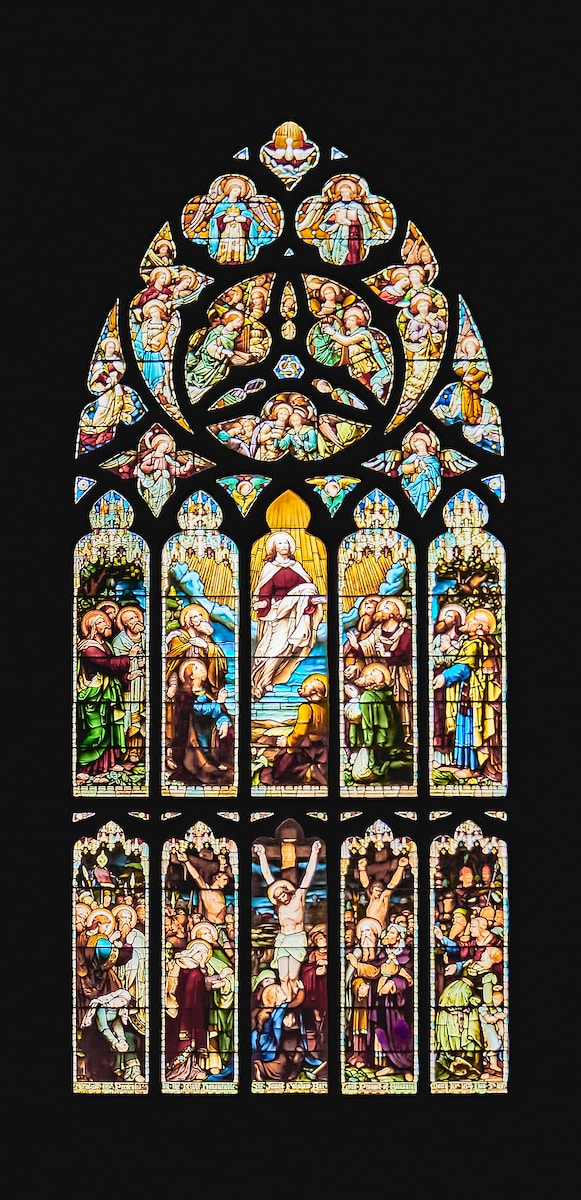This article explores Isaiah 60:19 and its significance in Christian theology, discussing the everlasting light, Gods glory, and Jesus illuminating presence, as well as its relevance to believers today and the hope represented by the dawn of Christs resurrection.

Photo by Simon Wilkes on Unsplash | Commercial use allowed
Isaiah 60:19 – The Everlasting Light and God’s Glory
Isaiah 60:19 resounds with the prophetic declaration that the sun and moon will no longer be required as sources of light, for the Lord Himself will be the everlasting light, and God will be the glory of His people. This verse portrays a profound truth about the eternal radiance of God’s presence and the transformative power of His illuminating glory. The imagery of the Lord as the everlasting light holds immense significance in Christian theology, transcending the temporal limitations of earthly sources of light and symbolizing the eternal illumination and spiritual enlightenment provided by God.
An example of the everlasting light and divine glory can be found in the book of Revelation, which echoes the sentiments expressed in Isaiah 60:19. Revelation 21:23 depicts the heavenly Jerusalem, proclaiming that it does not need the sun or the moon to shine on it, for the glory of God gives it light, and the Lamb is its lamp. This parallel not only reinforces the enduring message of God’s everlasting light but also underscores the continuity of divine illumination across different sections of the Bible, affirming the timeless and unchanging nature of God’s radiance.
Furthermore, the concept of God as the everlasting light serves as a source of hope and assurance for believers, signifying the unshakeable nature of God’s sovereignty and the promise of His eternal presence. As believers navigate through the ebb and flow of life’s challenges, the imagery of the Lord as the everlasting light offers a steadfast beacon, guiding them through the shadows of uncertainty and illuminating the path towards spiritual fulfillment and divine communion.
#Isaiah60 #RadiantGlory #DivineLight #JesusPresence #SpiritualEnlightenment #Illumination #Transformation #SpiritualRadiance #LightoftheWorld #Guidance #Hope #EternalLife #DivinePresence #SpiritualAwakening #Truth #Salvation
 Context and Background of Isaiah 60
Context and Background of Isaiah 60
Isaiah 60 unfolds as a prophetic proclamation of hope and restoration amidst prevailing darkness, emphasizing the imagery of the dawn symbolizing the resurrection and the renewal of creation. The prophet’s poignant depiction of darkness in the present context reflects the spiritual and emotional brokenness of humanity, resonating with the prevailing challenges and uncertainties of the contemporary world. However, the imagery of the dawn signifies the appearance of God’s glory, bringing about transformation, healing, and the promise of divine intervention in the face of adversity.
In the midst of the global turmoil brought about by the COVID-19 pandemic, the relevance of Isaiah 60’s imagery of the dawn as a symbol of spiritual awakening and renewal becomes even more poignant. This context invites contemplation on the enduring significance of the dawn’s symbolism, offering a guiding light through the shadows of despair and pointing towards the eternal hope and restoration found in God’s promises.
An example of the timeless relevance of Isaiah 60 can be found in the reflections of contemporary theologians, who draw parallels between the prophet’s vision and the current challenges faced by individuals and communities. The imagery of the dawn as a symbol of renewed hope and divine intervention provides a source of solace and inspiration, resonating with believers seeking spiritual rejuvenation amidst the uncertainties and trials of the present age. This enduring relevance underscores the transcendent nature of Isaiah 60’s message, offering a timeless beacon of hope and renewal for all who seek solace in the divine promises.
Interpretation and Significance in Christian Theology
Isaiah 60:19 holds a central place in the interpretation and significance of Christian theology, offering a profound revelation of the heavenly Jerusalem and the radiance of the Divine Presence. The verse’s portrayal of the Lord as the everlasting light and the glory of His people signifies a future reality where the need for natural sources of light will be replaced by the eternal radiance of God, illuminating the heavenly realm with divine glory. This imagery holds deep theological significance, portraying the unchanging nature of God’s presence and the everlasting radiance of His glory, which transcends all temporal limitations.
The verse’s connection to other significant passages in the Bible, such as Revelation 21:23 and 22:5, further reinforces its enduring significance in Christian theology. The imagery of the heavenly Jerusalem, depicted in Revelation, resonates with the themes of eternal light and divine radiance, offering a captivating portrayal of the unending glory of God and the transformative power of His illuminating presence. Therefore, the interpretation and significance of Isaiah 60:19 in Christian theology not only offer a glimpse into the heavenly realm but also serve as a beacon of hope, reminding believers of the unchanging nature of God’s light and glory, which transcends all temporal challenges.
An example of the enduring significance of Isaiah 60:19 in Christian theology can be found in the reflections of theologians and scholars who expound on its profound theological implications. Through their interpretations, the verse serves as a conduit for exploring the timeless themes of divine radiance, spiritual illumination, and the unchanging nature of God’s presence. These interpretations not only enrich the theological discourse surrounding Isaiah 60:19 but also underscore its enduring relevance as a source of spiritual enlightenment and hope for believers across generations.
 The Theme of Light in the Gospel
The Theme of Light in the Gospel
The theme of light shining in darkness, as depicted in Isaiah 60:1-5, is deeply rooted in the Gospel, signifying the profound impact of Jesus Christ as the true light. This metaphorical representation of light serves as a beacon of hope and salvation, illuminating the path for those shrouded in spiritual darkness, offering guidance, and dispelling despair. Just as light penetrates and eradicates darkness, the message of Christ’s light resonates with the call for spiritual enlightenment, prompting individuals to open their hearts to the radiance of divine truth and grace.
Moreover, the theme of light in the Gospel is not merely symbolic but holds practical significance in inspiring believers to live out their faith as beacons of Christ’s light in their communities. By internalizing the illuminating presence of Jesus, individuals are empowered to embody the virtues of compassion, kindness, and love, thereby becoming conduits of positive change and sources of comfort in a world fraught with challenges and hardships. This transformative power of Christ’s light is not confined to personal salvation but extends to the collective responsibility of believers to be catalysts for societal transformation, ushering in a renewed sense of hope and purpose.
An example of the profound impact of the theme of light in the Gospel can be found in historical accounts of individuals and communities who have been transformed by the radiance of Christ’s light. Through acts of compassion, forgiveness, and selflessness, believers have exemplified the transformative power of Christ’s light, bringing about tangible change in their surroundings and inspiring hope in the midst of despair. These examples serve as compelling testimonies to the enduring relevance of the Gospel’s message, showcasing the timeless impact of Christ’s light in dispelling darkness and ushering in spiritual renewal.
Relevance of Isaiah 60:19 to the Church
The connection between Isaiah 60:19 and the Church is profound and multi-faceted, signifying its integral role in the fulfillment of divine prophecy. As referenced in the Church is not merely a passive observer but an active participant in the diffusion of divine light, symbolizing the transformative power of God’s radiance. This duty extends to missionary endeavors, where the Church becomes a conduit for illuminating the path to spiritual enlightenment and the worship of Almighty God. Through these efforts, the Church actively contributes to the restoration of power and influence among the nations, thereby fulfilling the prophecy outlined in Isaiah 60.
Moreover, the well-being and prosperity of the Church are intricately intertwined with its perpetuation of God’s light, purity, and the absence of all earthly ills. In this sense, the Church becomes a custodian of divine radiance and spiritual prosperity, embodying the promise of perpetual enjoyment of all desired good and security. This highlights the profound responsibility bestowed upon the Church to serve as a steadfast source of divine illumination and spiritual well-being, echoing the enduring message of Isaiah 60:19 and its relevance to the Church in contemporary times.
An example of the Church’s fulfillment of the prophecy in Isaiah 60 can be found in historical accounts and contemporary narratives of missionary efforts and spiritual outreach. Through initiatives aimed at sharing the Gospel and extending acts of compassion and charity, the Church has played a pivotal role in diffusing the light of Christ’s presence to individuals and communities across the globe. These examples not only underscore the enduring relevance of Isaiah 60’s message but also demonstrate the transformative impact of the Church’s role in fulfilling the prophecy of divine radiance and spiritual prosperity.
 The Church’s Promise of Restoration and Growth
The Church’s Promise of Restoration and Growth
The promise of the Church’s restoration and growth, as outlined in Isaiah 60, is deeply intertwined with the divine assurance of God’s perpetual presence and guidance within the faith community. This profound promise signifies the certainty and accomplishment of restoration, growth, and prosperity, affirming the unwavering faithfulness of God towards His Church. It serves as a beacon of hope, illuminating the path for the Church to thrive and fulfill its divine purpose in diffusing the light of Christ’s presence.
The assurance of restoration and growth within the Church extends beyond mere material prosperity; it encompasses the spiritual rejuvenation, joy, and the absence of all earthly evils experienced by the faithful. This pledge portrays the Church as a sanctuary of purity, joy, and divine favor, where the light of God shines perpetually, dispelling darkness and ushering in spiritual abundance. Through this promise, believers are encouraged to embrace their role as vessels of God’s light, actively participating in the fulfillment of the divine plan for the Church’s restoration and expansion.
An example of the Church’s restoration and growth can be found in historical accounts and contemporary narratives of spiritual revival and community transformation. Through seasons of adversity and challenges, the Church has experienced periods of renewal and growth, marked by a deepened sense of spiritual fervor and divine favor. These examples serve as compelling testimonies to the enduring promise of restoration and growth within the Church, showcasing the transformative impact of God’s perpetual presence and guidance in nurturing spiritual abundance and collective prosperity.
Parallelism with Other Bible Verses
Isaiah 60:19 is intricately connected to other verses in the Bible, such as Revelation 21:23 and 22:5, which serve to enrich and deepen its profound message. Revelation 21:23 describes the heavenly Jerusalem, stating, “The city does not need the sun or the moon to shine on it, for the glory of God gives it light, and the Lamb is its lamp”. This imagery resonates with Isaiah 60:19, reinforcing the notion of God’s everlasting light and the radiance of His divine presence. Similarly, Revelation 22:5 proclaims, “There will be no more night. They will not need the light of a lamp or the light of the sun, for the Lord God will give them light. And they will reign forever and ever”. This verse reverberates with the concept of perpetual light and the eternal illumination bestowed by God, echoing the sentiments expressed in Isaiah 60:19.
The parallelism with these verses not only underscores the continuity of divine illumination and glory across different sections of the Bible but also reinforces the timeless and unchanging nature of God’s light. It signifies the overarching narrative of God’s eternal radiance and the fulfillment of His promises, serving as a testament to the enduring significance of Isaiah 60:19 within the broader biblical context. Through these connections, the verse transcends its immediate context, resonating with the themes of divine radiance and spiritual enlightenment that reverberate throughout the scriptures, offering believers a profound and unshakeable assurance of God’s eternal light and glory.
An example of the parallelism between Isaiah 60:19 and other biblical verses can be found in the reflections of theologians and scholars who expound on the interconnected themes of divine radiance and spiritual illumination. Through their interpretations and exegesis, these experts draw compelling parallels between Isaiah 60:19 and other verses, showcasing the continuity of divine illumination and the enduring promise of God’s eternal light. These examples not only enrich the theological discourse surrounding Isaiah 60:19 but also underscore its profound interconnectedness with the broader biblical narrative, offering believers a deeper understanding of the timeless themes of divine radiance and spiritual enlightenment.
Hope Represented by the Dawn of Christ’s Resurrection
Isaiah 60-62 vividly portrays the imagery of the dawn, symbolizing the prevailing darkness in the world and the hope represented by the dawn of Christ’s resurrection, which is profoundly relevant in the context of the COVID-19 pandemic. The prophet’s depiction of darkness reflects the spiritual and emotional brokenness of people, while the dawn signifies the appearance of God’s glory, bringing transformation and healing to Zion. This imagery of the dawn not only symbolizes the resurrection but also emphasizes the renewal of creation, resonating with the challenges and yearnings of today’s world, especially amidst the uncertainties and trials brought about by the pandemic.
Furthermore, the dawn as a symbol of Christ’s resurrection serves as a powerful reminder of the enduring message of hope and restoration. Just as the dawn signifies the arrival of light after darkness, the resurrection of Christ offers a beacon of hope, portraying a divine intervention that transcends human struggles and suffering. This parallel between the dawn of Christ’s resurrection and the current global predicament underscores the timeless significance of Isaiah’s vision, affirming the unwavering promise of spiritual renewal and divine intervention in the face of adversity.
An example of the enduring relevance of the dawn’s symbolism can be found in historical accounts and contemporary narratives of individuals and communities who have found solace and inspiration in the promise of Christ’s resurrection. Through their experiences of spiritual awakening and renewal, believers have exemplified the enduring impact of the dawn’s symbolism, bringing about tangible change and hope in the midst of despair. These examples serve as compelling testimonies to the enduring relevance of Isaiah 60’s vision, showcasing the timeless message of hope and restoration found in the dawn of Christ’s resurrection.



